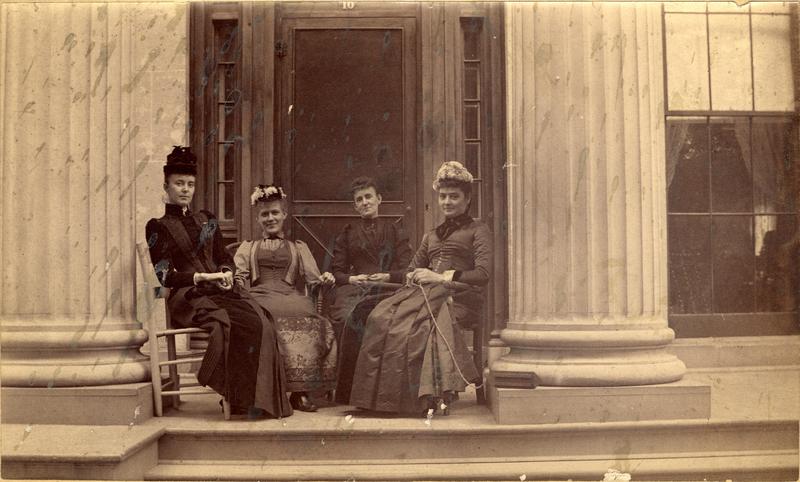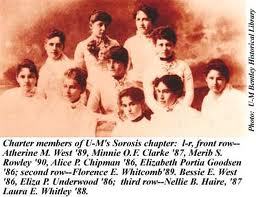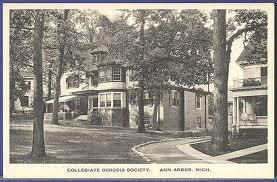Sororities
Kappa Alpha Theta was the first “women’s fraternity” at the University of Michigan.1 It opened its doors to women in 1879 before the term “sorority” was even in use.2
While early sororities had to fight for respect at the University, sororities were an important part of women’s space at Michigan by the time Myra Beach Jordan became the second Dean of Women. Sorority houses were one of the Dean of Women's approved housing options for female students.
“The advent of the sorority was considered a joke by the fraternity men.”3
As more women began enrolling and housing shortages began to plague the Office of the Dean of women, the expansion of the sorority network and their ability to house women became increasingly important.4
Sororities provided and continue to provide women on campus with a more personalized experience at a large University, and served as organizations around which women could structure their social lives. Sororities and fraternaties held formals and hops, opportunities for women to fill their dance cards and meet other students involved in Greek life.
In the 1880s, members of Kappa Alpha Theta began issuing charters to other colleges that were not ranked nationally in scholastics. As a result, the national chapter of the fraternity withdrew the University of Michigan charter in 1886.5
Unwilling to give up their organzation, 15 ex-members started their own local collegiate chapter of Collegiate Sorosis, which was a women's organization established in New York City in 1868. Although Kappa Alpha Theta was reestablished at Michigan, Collegiate Sorosis remained an organization within the Panhellenic Council until the late 20th century. Later called Chi Sigma, the local chapter disbanded after about 100 years of existence.6
The first black sorority, Delta Sigma Theta, was instated in 1921 by five women on a campus in which segregation was the norm, if not official University policy. 7 Today there are four culturally-based sororities that are a part of the Panhellenic Council. Black women were also instrumental in forming the Negro-Caucasian Club in 1925, which was one of the first inter-racial organizations on a North American university campus, according to a 1969 copy of the University of Michigan Review.
1. "History of Greek Life at the University of Michigan | Greek Life," History of Greek Life at the University of Michigan | Greek Life, Accessed August 23, 2016, https://greeklife.umich.edu/timeline/689/history-greek-life-university-michigan/3.
2. "Student Involvement," General History of Fraternities and Sororities in the United States, Accessed August 23, 2016, http://www.sjsu.edu/getinvolved/frso/history/usfslhistory/.
3. Wilfred B. Shaw, The University of Michigan, An Encyclopedic Survey (Ann Arbor: University of Michigan, 1941), Accessed August 23, 2016, http://mirlyn.lib.umich.edu/Record/003343150/Holdings#0.
4. The President's Report to the Board of Regents for the Academic Year, 1958 (Ann Arbor: University of Michigan), 53.
"Collegiate Sorosis at the University of Michigan – Gone But Not Forgotten," February 18, 2012, Accessed August 23, 2016, http://www.franbecque.com/2012/02/18/collegiate-sorosis-at-the-university-of-michigan-gone-but-not-forgottenn/.
6. Ibid.
7. "Nu Chapter History," Delta Sigma Theta Sorority Inc, Accessed August 23, 2016, http://nudeltas.studentorgs.umich.edu/history.php.




